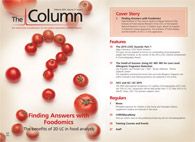Fraudulent Dietary Supplement Analysis
On Monday 2 February the New York State Attorney General’s office sent letters to four major retailers accusing them of selling fraudulent herbal supplements and demanding that they remove the products from their shelves. To the surprise of many analytical chemists, however, the accusations were based on DNA barcoding technology rather than chromatographic analysis.
On Monday 2 February the New York State Attorney General’s office sent letters to four major retailers accusing them of selling fraudulent herbal supplements and demanding that they remove the products from their shelves. To the surprise of many analytical chemists, however, the accusations were based on DNA barcoding technology rather than chromatographic analysis.
The letters said that testing had shown that multiple products of the store brands of the retailers - GNC, Target, Walmart, and Walgreens - contained little or none of the primary ingredient and in many cases showed the presence of other ingredients, such as rice. The products tested included a range of herbal supplements, such as gingko biloba, ginseng, echinacea, and St. John’s wort.
The fact that the DNA testing failed to show evidence of the primary ingredient is not surprising, according to James NealâKababick of Flora Research Laboratories, an independent laboratory in Oregon, USA, that specializes in testing dietary supplements. “The processing that botanical materials undergo when being prepared as supplements often denatures the DNA of the botanical material,” he explained.
This is particularly true of botanical extracts, he said, which typically undergo hydroalcoholic extraction with heat, followed by a spray-drying process. The alcohol generally denatures most of the DNA, and the heat and spray drying often destroys the rest. “You could have an extract that is 99% St. John’s wort and still not see any DNA,” he said. Botanical products prepared as powders may also have their DNA destroyed by heat or heat steam bioburden reduction processes, he added.
The U.S. Pharmacopeia and other standard-setting bodies around the world contain monographs for herbal products that indicate what tests should be used for identity testing. In most cases, the indicated methods include high performance liquid chromatography (HPLC) and highâperformance thin-layer chromatography (HPTLC). “Chromatography should have been the primary technique used in this case,” said Neal-Kababick.“It is mind boggling to me that it wasn’t.”
Neal-Kababick, who has been analyzing supplements for more than 20 years, added that the failure rates for botanical identity tests conducted in his laboratory - which analyzes several hundred such samples a month - are around 5%, nowhere near the 60–100% failures reported in this case.
The fact that the testing revealed DNA of other materials, such as rice, is also not surprising, Neal-Kababick said. Rice is a common excipient in herbal capsules and because of its hard outer coat, can be cleaned simply by washing it, which does not denature its DNA. That is not true for the flowers or leaves of a plant like St. John’s wort, where washing might extract the phytochemical ingredient.
Other material identified in the testing is likely to be small amounts of contaminants, such as insect and other plant material (such as pollen) picked up during harvesting or processing of the botanicals, he added. For food products such as herbs and spices, the U.S. Food and Drug Administration has a “defect action level” that specifies the amount of foreign matter or defective material (such as leaves partly eaten by insects) that is permissible. Likewise, the monographs for herbal supplements in most pharmacopeias include a section on foreign organic matter indicating the types and amounts that are allowed. - L.B.
For more on this story, visit:
www.chromatographyonline.com/supplements-industry-plans-further-testing-products-branded-fraudulent

University of Rouen-Normandy Scientists Explore Eco-Friendly Sampling Approach for GC-HRMS
April 17th 2025Root exudates—substances secreted by living plant roots—are challenging to sample, as they are typically extracted using artificial devices and can vary widely in both quantity and composition across plant species.
Thermodynamic Insights into Organic Solvent Extraction for Chemical Analysis of Medical Devices
April 16th 2025A new study, published by a researcher from Chemical Characterization Solutions in Minnesota, explored a new approach for sample preparation for the chemical characterization of medical devices.










